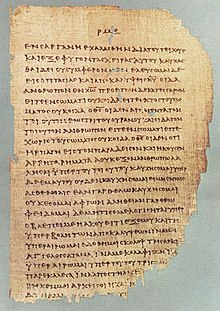2. Paul's letter to the Corinthians
| New Testament |
|---|
| Gospels |
| Acts of the Apostles |
| Paul's letters |
| Catholic letters |
| epiphany |
The 2nd Letter of Paul to the Corinthians or 2nd Corinthians ( Latin Epistula ad Corinthios II ) is a book of the New Testament of the Christian Bible . It has been divided into 13 chapters since the Middle Ages.
author
According to his own statement, Paul is the author and his pupil Timothy is co-author of the letter ( 2 Cor 1,1 LUT ). The drafting by Paul or Timothy is generally recognized. Some exegetes suspect that the letter consists of various letters from Paul, which were put together by his students in a coherent text.
Addressees
Paul's 2nd letter is addressed to the Christian community in the Greek port city of Corinth and the communities in Achaea ( 2 Cor 1 : 1 EU ), because there the Christian faith becoming a home in a pagan culture was associated with many problems. Paul already addressed these observations in his first letter .
The situation in the Corinthian church was so tense that Paul came to the city on another visit. This stay was short-lived because part of the community refused him recognition and obedience ( 2 Cor 10 : 1–10 EU ). Paul left Corinth in the summer of 55 and went to Macedonia via Troas .
Dating
In Macedonia, Paul received the message from his pupil Titus that the Corinthians had seen their injustice and had repentantly returned to obedience ( 2 Cor 7 : 6–16 EU ). Thereupon Paul wrote the 2nd letter to the Corinthians in the year 56 (2 Corinthians).
content

The theme of 2 Corinthians is service, which makes it comparable to Paul's letter to Philemon (Phlm). Nevertheless, both letters treat the subject from different perspectives: In the Phlm, Paul woos the congregation to grow into the service of the Lord. In 2Cor, on the other hand, Paul speaks as the servant of Christ who has to speak to the conscience of his community.
After the address and the greeting ( 2 Cor 1, 1–2 EU ) the letter can be structured as follows:
- Community of consolation (2 Cor 1: 3-2: 14)
- The right service for Christ (2 Cor 2: 12-6: 10)
- Rules of life of the community (2 Cor 6.11-9.15)
- The authority of the apostle (2 Cor 10.1-13.10).
- Closing words and blessings ( 2 Cor 13.11–13 EU ).
See also
literature
- Bärbel Bosenius: The absence of the apostle as a theological program. The second letter to the Corinthians as an example of the correspondence of Pauline theology . Francke, Tübingen 1994, ISBN 3-7720-1862-9 .
- Werner Kleine: Between fear and hope. A text-linguistic investigation of the letter 2 Cor 1–9 on the mutual importance of apostle and congregation (BBB 141). Philo, Berlin 2002, ISBN 3-8257-0323-1 .
- Andreas Lindemann: The biblical hermeneutics of Paul. Observations on 2 Cor 3 . In: WuD 23. 1995, pp. 125-152.
- Jens Schröter : The reconciled reconciler. Paul as an indispensable mediator in the process of salvation between God and the community according to 2 Cor. 2.14-7.4 . Francke, Tübingen 1993, ISBN 3-7720-1889-0 .
Web links
- Interpretation and scientific literature on the second letter to the Corinthians
- Information about the 2nd letter to the Corinthians bibelwissenschaft.de
- 2. Read Corinthians letter online (Luther 2017) These and over 40 other current and historical Bible translations at Bibleserver.com .
Remarks
- ^ Xavier Léon-Dufour: Dictionary of the New Testament. Kösel, Munich 1977, ISBN 3-466-20144-6 , Lemma Korinther Briefe .
- ^ Fritz Rienecker, Gerhard Maier: Lexicon for the Bible. Brockhaus, Wuppertal 1998, ISBN 3-417-24678-4 , Lemma Korintherbriefe .
- ↑ a b Fritz Rienecker, Gerhard Maier: Lexicon for the Bible. Brockhaus, Wuppertal 1998, ISBN 3-417-24678-4 , pp. 930f.